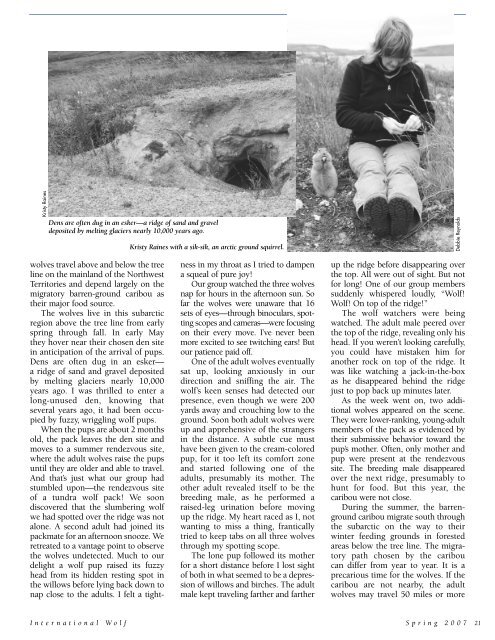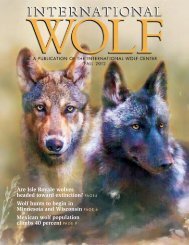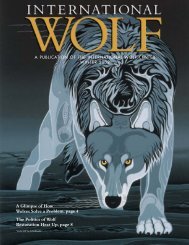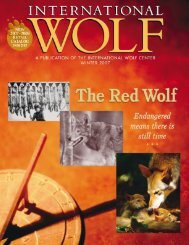a publication of the international wolf center spring 2007
a publication of the international wolf center spring 2007
a publication of the international wolf center spring 2007
Create successful ePaper yourself
Turn your PDF publications into a flip-book with our unique Google optimized e-Paper software.
Kristy Raines<br />
Dens are <strong>of</strong>ten dug in an esker—a ridge <strong>of</strong> sand and gravel<br />
deposited by melting glaciers nearly 10,000 years ago.<br />
wolves travel above and below <strong>the</strong> tree<br />
line on <strong>the</strong> mainland <strong>of</strong> <strong>the</strong> Northwest<br />
Territories and depend largely on <strong>the</strong><br />
migratory barren-ground caribou as<br />
<strong>the</strong>ir major food source.<br />
The wolves live in this subarctic<br />
region above <strong>the</strong> tree line from early<br />
<strong>spring</strong> through fall. In early May<br />
<strong>the</strong>y hover near <strong>the</strong>ir chosen den site<br />
in anticipation <strong>of</strong> <strong>the</strong> arrival <strong>of</strong> pups.<br />
Dens are <strong>of</strong>ten dug in an esker—<br />
a ridge <strong>of</strong> sand and gravel deposited<br />
by melting glaciers nearly 10,000<br />
years ago. I was thrilled to enter a<br />
long-unused den, knowing that<br />
several years ago, it had been occupied<br />
by fuzzy, wriggling <strong>wolf</strong> pups.<br />
When <strong>the</strong> pups are about 2 months<br />
old, <strong>the</strong> pack leaves <strong>the</strong> den site and<br />
moves to a summer rendezvous site,<br />
where <strong>the</strong> adult wolves raise <strong>the</strong> pups<br />
until <strong>the</strong>y are older and able to travel.<br />
And that’s just what our group had<br />
stumbled upon—<strong>the</strong> rendezvous site<br />
<strong>of</strong> a tundra <strong>wolf</strong> pack! We soon<br />
discovered that <strong>the</strong> slumbering <strong>wolf</strong><br />
we had spotted over <strong>the</strong> ridge was not<br />
alone. A second adult had joined its<br />
packmate for an afternoon snooze. We<br />
retreated to a vantage point to observe<br />
<strong>the</strong> wolves undetected. Much to our<br />
delight a <strong>wolf</strong> pup raised its fuzzy<br />
head from its hidden resting spot in<br />
<strong>the</strong> willows before lying back down to<br />
nap close to <strong>the</strong> adults. I felt a tight-<br />
Kristy Raines with a sik-sik, an arctic ground squirrel.<br />
ness in my throat as I tried to dampen<br />
a squeal <strong>of</strong> pure joy!<br />
Our group watched <strong>the</strong> three wolves<br />
nap for hours in <strong>the</strong> afternoon sun. So<br />
far <strong>the</strong> wolves were unaware that 16<br />
sets <strong>of</strong> eyes—through binoculars, spotting<br />
scopes and cameras—were focusing<br />
on <strong>the</strong>ir every move. I’ve never been<br />
more excited to see twitching ears! But<br />
our patience paid <strong>of</strong>f.<br />
One <strong>of</strong> <strong>the</strong> adult wolves eventually<br />
sat up, looking anxiously in our<br />
direction and sniffing <strong>the</strong> air. The<br />
<strong>wolf</strong>’s keen senses had detected our<br />
presence, even though we were 200<br />
yards away and crouching low to <strong>the</strong><br />
ground. Soon both adult wolves were<br />
up and apprehensive <strong>of</strong> <strong>the</strong> strangers<br />
in <strong>the</strong> distance. A subtle cue must<br />
have been given to <strong>the</strong> cream-colored<br />
pup, for it too left its comfort zone<br />
and started following one <strong>of</strong> <strong>the</strong><br />
adults, presumably its mo<strong>the</strong>r. The<br />
o<strong>the</strong>r adult revealed itself to be <strong>the</strong><br />
breeding male, as he performed a<br />
raised-leg urination before moving<br />
up <strong>the</strong> ridge. My heart raced as I, not<br />
wanting to miss a thing, frantically<br />
tried to keep tabs on all three wolves<br />
through my spotting scope.<br />
The lone pup followed its mo<strong>the</strong>r<br />
for a short distance before I lost sight<br />
<strong>of</strong> both in what seemed to be a depression<br />
<strong>of</strong> willows and birches. The adult<br />
male kept traveling far<strong>the</strong>r and far<strong>the</strong>r<br />
up <strong>the</strong> ridge before disappearing over<br />
<strong>the</strong> top. All were out <strong>of</strong> sight. But not<br />
for long! One <strong>of</strong> our group members<br />
suddenly whispered loudly, “Wolf!<br />
Wolf! On top <strong>of</strong> <strong>the</strong> ridge!”<br />
The <strong>wolf</strong> watchers were being<br />
watched. The adult male peered over<br />
<strong>the</strong> top <strong>of</strong> <strong>the</strong> ridge, revealing only his<br />
head. If you weren’t looking carefully,<br />
you could have mistaken him for<br />
ano<strong>the</strong>r rock on top <strong>of</strong> <strong>the</strong> ridge. It<br />
was like watching a jack-in-<strong>the</strong>-box<br />
as he disappeared behind <strong>the</strong> ridge<br />
just to pop back up minutes later.<br />
As <strong>the</strong> week went on, two additional<br />
wolves appeared on <strong>the</strong> scene.<br />
They were lower-ranking, young-adult<br />
members <strong>of</strong> <strong>the</strong> pack as evidenced by<br />
<strong>the</strong>ir submissive behavior toward <strong>the</strong><br />
pup’s mo<strong>the</strong>r. Often, only mo<strong>the</strong>r and<br />
pup were present at <strong>the</strong> rendezvous<br />
site. The breeding male disappeared<br />
over <strong>the</strong> next ridge, presumably to<br />
hunt for food. But this year, <strong>the</strong><br />
caribou were not close.<br />
During <strong>the</strong> summer, <strong>the</strong> barrenground<br />
caribou migrate south through<br />
<strong>the</strong> subarctic on <strong>the</strong> way to <strong>the</strong>ir<br />
winter feeding grounds in forested<br />
areas below <strong>the</strong> tree line. The migratory<br />
path chosen by <strong>the</strong> caribou<br />
can differ from year to year. It is a<br />
precarious time for <strong>the</strong> wolves. If <strong>the</strong><br />
caribou are not nearby, <strong>the</strong> adult<br />
wolves may travel 50 miles or more<br />
International Wolf Spring <strong>2007</strong> 21<br />
Debbie Reynolds







